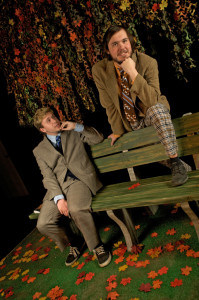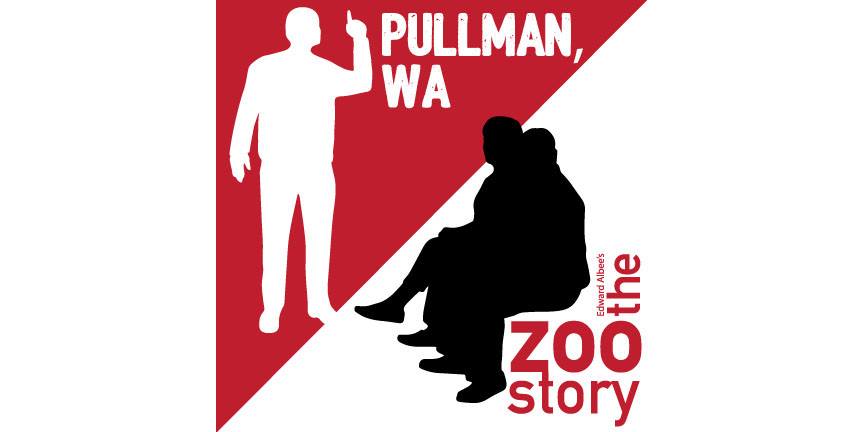Can you believe in something or relive something that never actually happened? Do you know how to live your life? The students involved with the Academic Theaters of CCBC certainly seem intent on proving that you can and that they do, and so too can you if you attend their current double-feature production of Edward Albee’s The Zoo Story and Pullman, WA written by Young Jean Lee. Directed by Julie Lewis, this fascinating juxtaposition of realistic absurdism and absurd realism brings five exceptionally talented aspiring acting students to the stage for just under two hours of intriguing and evocative entertainment that will have you marveling over your own life choices and relatable moments therein.
Featured as a double bill with a cast of five actors in total, Edward Albee’s two-hander The Zoo Story gets the audience started for the program, followed by a brief intermission where the audience is excused for what may officially be the most efficiently executed scenic shift— led by Stage Manager Thomas P. Gardner— before concluding the performance with Young Jean Lee’s Pullman, WA. Both absurdist and strangely realistic in their nature these two darkly comedic dramatic snippets are prime real estate for the stage when it comes to showcasing a range of skills in the craft of acting.

Adding to the aesthetic and atmospheric appeal of the first half of the double-bill, Sound Designer Jason Randolph pipes an almost undetectable underscoring of city traffic into the background as the play unfolds. The traffic is subtle, echoing the busy streets of 1958 rather than the obnoxious blare of 2015. Randolph even includes the occasional bird chirp and whisper of a warm afternoon’s breeze in his sound design, all intricate nuances that add a touch of finesse to the show as a whole.
Director Julie Lewis guides the two performers through Albee’s bizarre play with vigor and gusto. Her minor misstep in the hair-style and full beard choice of actor Charles Gearhart is the one thing that detracts from the piece as it gives Gearhart a more modern-day madman look rather than the scuzzy late 50’s bum that the script calls for. This is especially noticeable because of how crisp and sharp Tim Neil’s character is presented with his short smoothed hair tucked away beneath his hat. The difference in their societal statuses and overall temperaments is achieved so thoroughly by the students’ performances that it is a shame to have such a minor thing to detract from their stellar work.

Charles Gearhart and Tim Neil have devastatingly striking chemistry between them that is developed almost immediately once the play begins. While Gearhart’s character never stops prattling on in his frenetic and almost frantic manner, it’s the silences and contemplative reactions and responses from Neil’s character that really drive the scenes forward. The slightly unbalanced nature of their character’s existences together in Central Park is handled with a beautiful working knowledge of stranger-interactions by both performers.

Gearhart undertakes the massive challenge of keeping a perpetually chatty character engaging. His unyielding frenetic energy is externalized, which is a sharp contrast to the steady and sturdy internalized energy portrayed by Neil. The fact that Gearhart channels most of this energy and excitement into his textual delivery leaving him fairly still while sitting on or standing next to the bench is mind-boggling and simultaneously fascinating. There is a maddening drive of a jumble of emotions clearly present in Gearhart’s portrayal of spastic Jerry, though just where these various emotions stem from is somewhat unclear. That is not to say his performance on the whole is unfocused, but specific emotional outbursts seem to bring a plethora of feelings to the foreground of his character’s existence without having any solid grounding beneath them. Fully embodying the nuances of the obnoxious irritant character, Gearhart attacks the absurdity of the situation, including a great many of his story-telling narrative monologues with exceptional aplomb.
Pullman, WA has no scenic design elements to speak of save for three enormous and brightly colored beanbag chairs that are pulled into existence when the script calls for it. This lack of design is intentional and allows the audience to focus more thoroughly on the absolute nonsense that unravels and bursts into a chaotic oblivion of shenanigans right before our eyes. Forget narrative, plot lines, and other linear occurrences as they are not applicable for the second half of the double-feature. Again Director Julie Lewis succeeds in motivating a captivating and engaging rapid-paced one-act to keep the audience fully engaged with what’s happening on the stage— whatever that may be in this case.


Balancing out these two spastically charged performances Alonzo Perez arrives on the scene like a pile of dandelion fluff that has floated down from somewhere unseen and brought haphazardly into the show by happenstance. His casual and gentle retelling of various bible and religious type allegories is strangely subduing. This is not to say that Perez does not possess his own incredibly charged energies, they just manifest differently.

Running Time: 1 hour and 50 minutes with one intermission
The Zoo Story and Pullman, WA double-feature plays through Tuesday December 8, 2015 at CCBC Academic Theatres Essex in the Studio Theatre of the Arts and Humanities (AHUM) Hall on the Campus of CCBC Essex— 7201 Rossville Boulevard, in Rosedale, MD. For tickets please call the box office at (443) 840-2787 or purchase them online.

